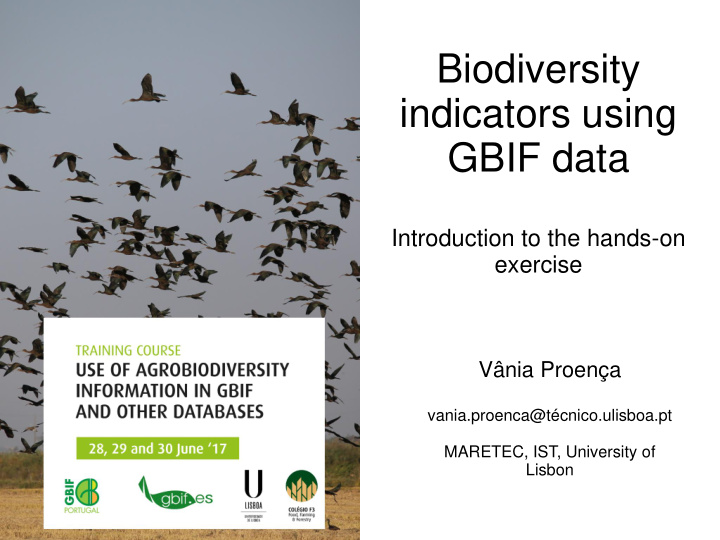



Biodiversity indicators using GBIF data Introduction to the hands-on exercise Vânia Proença vania.proenca@técnico.ulisboa.pt MARETEC, IST, University of Lisbon
TRAINING COURSE: USE OF AGROBIODIVERSITY INFORMATION 28, 29 AND 30 JUNE '17 IN GBIF AND OTHER DATABASES Biodiversity indicators are measures of biodiversity. Indicators respond to drivers of change and are used to assess and monitor the state and trends of biodiversity in all its dimensions. Breed and cultivar diversity Trends in conservation status Crop origin Red List Index (e.g., pollinators) (…) Living Planet Index Trends in invasive species (…) Genetic Individual species or taxa (i.e., species groups) Species communities (i.e., interacting popul.) Species Species diversity & evenness % Endemics, or rare species Ecosystems Trends in similarity % declining or increasing spcs. (…) Protected Area Coverage % forest under certified management (…)
TRAINING COURSE: USE OF AGROBIODIVERSITY INFORMATION 28, 29 AND 30 JUNE '17 IN GBIF AND OTHER DATABASES Agrobiodiversity Genetic Cultivated species Non-cultivated species Species Ecosystems Indicators Support/Regulation Threats Cultural value Biological control Invasive sp. Mushrooms Habitat specialists Pollinators Pathogens Rare/threatened sp. Medicinal plants Decomposers Herbivores Charismatic sp. Lichens etc. etc. Soil fertility etc. Nutrient cycling etc.
TRAINING COURSE: USE OF AGROBIODIVERSITY INFORMATION 28, 29 AND 30 JUNE '17 IN GBIF AND OTHER DATABASES Protocol to obtain reliable species community data from GBIF Extract biodiversity Revise extraction filters data from GBIF and / or add new data to GBIF Check quality of records - Taxonomic accuracy if few - Geographic accuracy or - Temporal accuracy Assess sampling effort none (survey completeness) Identify well-sampled cells Use in biodiversity Discard records assessment and with errors modelling Adapted from Hortal et al. 2007 Conservation Biology Volume 21, No. 3, 853 – 863; DOI: 10.1111/j.1523-1739.2007.00686.x Alternative: model the distribution of individual species and assemble comunities with overlapping distribution
TRAINING COURSE: USE OF AGROBIODIVERSITY INFORMATION 28, 29 AND 30 JUNE '17 IN GBIF AND OTHER DATABASES Relationship between sampling effort and observed species in grid cells Hortal et al. 2007 Conservation Biology Volume 21, No. 3, 853 – 863; DOI: 10.1111/j.1523-1739.2007.00686.x
TRAINING COURSE: USE OF AGROBIODIVERSITY INFORMATION 28, 29 AND 30 JUNE '17 IN GBIF AND OTHER DATABASES Species accumulation curves and rarefaction curves Gotelli, Nicholas J., and Robert K. Colwell. "Estimating species richness." Biological diversity: frontiers in measurement and assessment 12 (2011): 39-54.
TRAINING COURSE: USE OF AGROBIODIVERSITY INFORMATION 28, 29 AND 30 JUNE '17 IN GBIF AND OTHER DATABASES Rarefaction curves for bee communities from different surveys around the world Williams, N. M., R. L. Minckley, and F. A. Silveira. 2001. Variation in native bee faunas and its implications for detecting community changes. Conservation Ecology 5 (1): 7. [online] URL: http://www.consecol.org/vol5/iss1/art7/
TRAINING COURSE: USE OF AGROBIODIVERSITY INFORMATION 28, 29 AND 30 JUNE '17 IN GBIF AND OTHER DATABASES Estimation of species richness & Assessment of survey completeness Estimated 443 species Observed 352 species Singletons Doubletons Coddington, Jonathan A., et al. "Undersampling bias: the null hypothesis for singleton species in tropical arthropod surveys." Journal of animal ecology 78.3 (2009): 573-584.; DOI: 10.1111/j.1365-2656.2009.01525.x Survey completeness = (observed/estimated) * 100 If completeness > 75% accept as well-surveyed (352/443)* 100 = 79% OK!
TRAINING COURSE: USE OF AGROBIODIVERSITY INFORMATION 28, 29 AND 30 JUNE '17 IN GBIF AND OTHER DATABASES Bird data: 80 well-surveyed cells for 2010 in Alentejo GBIF Search query • Scientific name: (several bird orders) • Basis of Record : Human Observations • Location : Including coordinates and with no known issues • Month: from April to June • Country: Portugal • License : CC0 1.0
TRAINING COURSE: USE OF AGROBIODIVERSITY INFORMATION 28, 29 AND 30 JUNE '17 IN GBIF AND OTHER DATABASES Bird data: 35 well-surveyed cells for 2005 in Alentejo GBIF Search query • Scientific name: (several bird orders) • Basis of Record : Human Observations • Location : Including coordinates and with no known issues • Month: from April to June • Country: Portugal • License : CC0 1.0
TRAINING COURSE: USE OF AGROBIODIVERSITY INFORMATION 28, 29 AND 30 JUNE '17 IN GBIF AND OTHER DATABASES Free software packages with tools for estimating species richness from sample data: EstimateS (Colwell 2009): http://purl.oclc.org/estimates EcoSim (Gotelli & Entsminger 2009): http://garyentsminger.com/ecosim/index.htm SPADE : http://chao.stat.nthu.edu.tw/softwareCE.html VEGAN (for R ): http://cc.oulu.fi/ ∼ jarioksa/softhelp/vegan.html Gotelli, Nicholas J., and Robert K. Colwell. "Estimating species richness." Biological diversity: frontiers in measurement and assessment 12 (2011): 39-54.
TRAINING COURSE: USE OF AGROBIODIVERSITY INFORMATION 28, 29 AND 30 JUNE '17 IN GBIF AND OTHER DATABASES Protocol to obtain reliable species community data from GBIF Extract biodiversity Revise extraction filters data from GBIF and / or add new data to GBIF Check quality of records - Taxonomic accuracy if few - Geographic accuracy or - Temporal accuracy Assess sampling effort none (survey completeness) Identify well-sampled cells Use in biodiversity Discard records assessment and with errors modelling Adapted from Hortal et al. 2007 Conservation Biology Volume 21, No. 3, 853 – 863; DOI: 10.1111/j.1523-1739.2007.00686.x
Recommend
More recommend